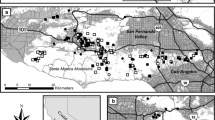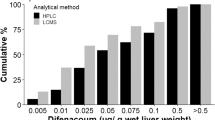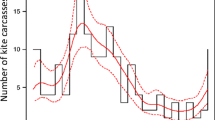Abstract
Among many anthropogenic drivers of population decline, continual rapid urbanization and industrialization pose major challenges for the survival of wildlife species. Barn owls (Tyto alba) in southwestern British Columbia (BC) face a multitude of threats ranging from habitat fragmentation to vehicle strikes. They are also at risk from secondary poisoning of second-generation anticoagulant rodenticides (SGARs), a suite of toxic compounds which at high doses results in a depletion of blood clotting factors leading to internal bleeding and death. Here, using long-term data (N = 119) for the hepatic residue levels of SGAR, we assessed the risk of toxicosis from SGAR for the BC barn owl population over the past two decades. We also investigated whether sensitivity to SGAR is associated with genetic factors, namely Single Nucleotide Polymorphisms (SNPs) found in the CYP2C45 gene of barn owls. We found that residue concentration for total SGAR was significantly higher in 2006–2013 (141 ng/g) relative to 1992–2003 (57 ng/g). The proportion of owls exposed to multiple SGAR types was also significantly higher in 2006–2013. Those measures accordingly translate directly into an increase in toxicosis risk level. We also detected demographic differences, where adult females showed on average lower concentration of total SGAR (64 ng/g) when compared to adult males (106 ng/g). Juveniles were overall more likely to show signs of toxicosis than adults (33.3 and 6.9 %, respectively), and those symptoms were positively predicted by SGAR concentrations. We found no evidence that SNPs in the CYP2C45 gene of barn owls were associated with intraspecific variation in SGAR sensitivity. We recommend several preventative measures be taken to minimize wildlife exposure to SGAR.


Similar content being viewed by others
References
Aithal GP, Day CP, Kesteven PJ, Daly AK (1999) Association of polymorphisms in the cytochrome P450 CYP2C9 with warfarin dose requirement and risk of bleeding complications. Lancet 353:717–719
Albert CA, Wilson LK, Mineau P, Trudeau S, Elliott JE (2010) Anticoagulant rodenticides in three owl species from western Canada, 1988–2003. Arch Environ Contam Toxicol 58:451–459
Baader M, Gnerre C, John J (2002) Transcriptional activation of Cytochrome P450 CYP2C45 by drugs is mediated by the chicken xenobiotic receptor (CXR) interacting with a phenobarbital response enhancer unit. J Biol Chem 277:15647–15653
Berny P (2007) Pesticides and the intoxication of wild animals. J Vet Pharmacol Ther 30:93–100
Bishop CA, Brogan JM (2013) Estimates of avian mortality attributed to vehicle collisions in Canada. Avian Conserv Ecol 8:2
Christensen TK, Lassen P, Elmeros M (2012) High exposure rates of anticoagulant rodenticides in predatory bird species in intensively managed landscapes in Denmark. Arch Environ Contam Toxicol 63:437–444
Corrigan RM (2001) Rodent control: a practical guide for pest management professionals. GIE Media, Cleveland
COSEWIC (2010) COSEWIC assessment and status report on the barn owl Tyto alba (Eastern population and Western population) in Canada. Committee on the Status of Endangered Wildlife in Canada, Ottawa, p xiv + 34
Eason CT, Henderson R, Hix S, MacMorran D, Miller A, Murphy E, Ross J, Ogilvie S (2010) Alternatives to brodifacoum and 1080 for possum and rodent control—how and why? N Z J Zool 37:175–183
Elliott JE, Hindmarch S, Albert CA, Emery J, Mineau P, Maisonneuve F (2014) Exposure pathways of anticoagulant rodenticides to nontarget wildlife. Environ Monit Assess 186:895–906
Elliott JE, Rattner BA, Shore RF, van den Brink NW (2016) Paying the Pipers: mitigating the impact of anticoagulant rodenticides on predators and scavengers. Bioscience (in press)
Elmeros M, Christensen TK, Lassen P (2011) Concentrations of anticoagulant rodenticides in stoats Mustela erminea and weasels Mustela nivalis from Denmark. Sci Total Environ 409:2373–2378
Fisher P, O’Connor C, Wright G, Eason CT (2004) Anticoagulant residues in rats and secondary poisoning risk. Doc Science Internal Series no. 188. Department of Conservation, Wellington
Gabriel MW, Woods LW, Poppenga R et al (2012) Anticoagulant rodenticides on our public and community lands: spatial distribution of exposure and poisoning of a rare forest carnivore. PLoS One 7:e40163
Giorgi M, Mengozzi G (2010) An HPLC method for the determination of bromadiolone plasma kinetics and its residues in hen eggs. J Chromatogr Sci 48:714–720
Harrell FE Jr (2001) Regression modeling strategies. Springer, New York
Higashi MK, Veenstra DL, Kondo LM, Wittkowsky AK, Srinouanprachanh SL, Farin FM, Rettie AE (2002) Association between CYP2C9 genetic variants and anticoagulation-related outcomes during warfarin therapy. J Am Med Assoc 287:1690–1698
Hindmarch S, Elliott JE (2015) A specialist in the city: the diet of barn owls along a rural to urban gradient. Urban Ecosyst 2:477–488
Hindmarch S, Krebs EA, Elliott JE, Green DJ (2012) Do landscape features predict the presence of barn owls in a changing agricultural landscape? Landsc Urban Plan 107:255–262
Hindmarch S, Krebs EA, Elliott JE, Green DJ (2014) Urban development reduces fledgling success of barn owls in British Columbia, Canada. Condor 116:507–517
Ishizuka M, Okajima F, Tanikawa T, Min H, Tanaka KD, Sakamoto KQ, Fujita S (2007) Elevated warfarin metabolism in warfarin-resistant roof rat (Rattus rattus) in Tokyo. Drug Metab Dispos 35:62–66
Kammerer M, Pouliquen H, Pinault L, Loyau M (1998) Residues depletion in egg after warfarin ingestion by laying hens. Vet Hum Toxicol 40:273–275
Kubota A, Yoneda K, Tanabe S, Iwata H (2013) Sex differences in the accumulation of chlorinated dioxins in the cormorant (Phalacrocorax carbo): implication of hepatic sequestration in the maternal transfer. Environ Pollut 178:300–305
Langford KH, Reid M, Thomas KV (2013) The occurrence of second generation anticoagulant rodenticides in non-target raptor species in Norway. Sci Total Environ 450:205–208
Li T, Lange LA, Li X, Susswein L, Bryant B, Malone R, Lange EM, Huang TY, Stafford DW, Evans JP (2006) Polymorphisms in the VKORC1 gene are strongly associated with warfarin dosage requirements in patients receiving anticoagulation. J Med Genet 43:740–744
Lopez-Perea J, Camarero PR, Molina-Lopez RA, Parpal L, Obon E, Sola J, Mateo R (2015) Interspecific and geographic differences in anticoagulant rodenticide residues of predatory wildlife from the Mediterranean region of Spain. Sci Total Environ 511:259–267
Marti CD, Poole AF, Bevier LR (2005) Barn owl (Tyto alba). In: Poole A (ed) The birds of North America, 1st edn. The Birds of North America Online, Ithaca
McKinney ML (2002) Urbanization, biodiversity and conservation. Bioscience 52:883–890
Meulenbelt I, Droog S, Trommelen GJ, Boonsma DI, Slagboom PE (1995) High-yield noninvasive human genomic DNA isolation method for genetic studies in geographically dispersed families and populations. Am J Hum Genet 57:1252–1254
Murray M (2011) Anticoagulant rodenticide exposure and toxicosis in four species of birds of prey presented to a wildlife clinic in Massachusetts, 2006–2010. J Zoo Wildl Med 42:88–97
Newton I, Dale L, Finnie JK, Freestone P, Wright J, Wyatt C, Wyllie I (1998) Wildlife and pollution: 1997/98 annual report. Joint Nature Conservation Committee Report, No. 285
Newton I, Shore RF, Wyllie I, Birks S, Dale L (1999) Empirical evidence of side-effects of rodenticides on some predatory birds and mammals. In: Cowan DP, Feare CJ (eds) Advances in vertebrate pest management. Filander Verlag, Furth, pp 347–367
PMRA (2010) Proposed risk mitigation measures for eight rodenticides. REV2010-17. Pest Management Regulatory Agency, Health Canada, Ottawa
Preston MI, Powers GI (2006) High incidence of vehicle induced owl mortality in the lower Mainland and central Fraser Valley. British Columbia Wildl Afield 3(Supplement):15–23
PRMA (2013) New use restrictions for commercial class rodenticides in agricultural settings. Pest management regulatory agency, Health Canada. http://sgspestmanagement.ca/wp-content/uploads/2013/03/PMRA-New-Restriction-Rodenticides-eng.pdf
Pruitt K, Brown G, Tatusova T, Maglott D (2002) In: McEntyre J, Ostell J (eds) The NCBI handbook [internet]. Bethesda (MD): National Center for Biotechnology Information (US). Chapter 18. http://www.ncbi.nlm.nih.gov/books/NBK21091/
Rattner BA, Horak KE, Lazarus RS, Goldade DA, Johnston JJ (2014) Toxicokinetics and coagulopathy threshold of the rodenticide diphacinone in eastern screech-owls (Megascops asio). Environ Toxicol Chem 33:74–81
Robinson SA, Lajeunesse MJ, Forbes MR (2012) Sex differences in mercury contamination of birds: testing multiple hypotheses with meta-analysis. Environ Sci Technol 46:7094–7101
Salim H, Noor HM, Hamid NH, Omar D, Kasim A, Abdin C (2015) The effects of rodenticide residues deposited in eggs of Tyto alba to eggshell thickness. Sains Malays 44:559–564
Sanchez-Barbudo IS, Camarero PR, Mateo R (2012) Primary and secondary poisoning by anticoagulant rodenticides of non-target animals in Spain. Sci Total Envioron 420:280–288
Sconce EA, Khan TI, Wynne HA, Avery P, Monkhouse L, King BP, Wood P, Kesteven P, Daly AK, Kamali F (2005) The impact of CYP2C9 and VKORC1 genetic polymorphism and patient characteristics upon warfarin dose requirements: proposal for a new dosing regimen. Blood 106:2329–2333
Serieys LEK, Armenta TC, Moriarty JG, Boydston EE, Lyren LM, Poppenga RH, Crooks KR, Wayne RK, Riley SPD (2015) Anticoagulant rodenticides in urban bobcats: exposure, risk factors and potential effects based on a 16-year study. Ecotoxicology 24:844–862
Shimshoni JA, Soback S, Cuneah O, Shloshberg A, Britzi M (2013) New validated multiresidue analysis of six 4-hydroxy-coumarin anticoagulant rodenticides in hen eggs. J Vet Diagn Invest 25:736–743
R Development Core Team (2011) R: a language and environment for statistical computing. R Foundation for statistical computing, Vienna. http://www.R-project.org/. Accessed 30 Nov 2015
Thomas PJ, Mineau P, Shore R, Champoux L, Martin PA, Wilson LK, Fitzgerald G, Elliott JE (2011) Second generation anticoagulant rodenticides in predatory birds: probabilistic characterization of toxic liver concentrations and implications for predatory bird populations in Canada. Environ Int 37:914–920
Traag WA, Kan CA, van der Weg G, Onstenk C, Hoogenboom LAP (2006) Residues of dioxins (PCDD/Fs) and PCBs in eggs, fat and livers of laying hens following consumption of contaminated feed. Chemosphere 65:1518–1525
Vandenbroucke V, Bousquet-Melou A, De Backer P, Croubels S (2008) Pharmacokinetics of eight anticoagulant rodenticides in mice after single oral administration. J Vet Pharmacol Ther 31:437–445
Walker LA, Chaplow JS, Moeckel C, Pereira MG, Potter ED, Shore RF (2014) Anticoagulant rodenticides in predatory birds 2012: a predatory bird monitoring scheme (PBMS) report. Centre for Ecology & Hydrology, Lancaster, p 18
Watanabe KP, Saengtienchai A, Tanak K, Ikenaka Y, Ishizuka M (2010) Comparison of warfarin sensitivity between rat and bird species. Comp Biochem Physiol Part C 152:114–119
Watanabe KP, Kawata M, Ikenaka Y, Nakayama SM, Ishii C, Darwish WS, Saengtienchai A, Mizukawa H, Ishizuka M (2015) Cytochrome P450—mediated warfarin metabolic ability is not a critical determinant of warfarin sensitivity in avian species: in vitro assays in several birds and in vivo assays in chicken. Environ Toxicol Chem 34:2328–2334
Webster KH, Harr KE, Bennett DC, Williams TD, Cheng KM, Maisonneuve F, Elliott JE (2015) Assessment of toxicity and coagulopathy of brodifacoum in Japanese quail and testing in wild owls. Ecotoxicology 24:1087–1101
Acknowledgments
We thank the following agencies for submitting owl carcasses to our agency: the British Columbia Ministry of Environment, Orphaned Wildlife Rehabilitation Society (OWL), Wildlife Rescue Association (WRA), and Mountainaire Avian Rescue Society (MARS). National Wildlife Research Centre staffs are thanked for specimen bank archiving and rodenticide residue analysis. All laboratory work took place at the Genetic Data Centre of UBC; we want to personally thank the research scientists (Carol Ritland, Allyson Miscampbell and Agnes Yuen) for providing their technical support and knowledge. This project was funded by the Pesticide Science Fund, the Science & Technology Branch, and the Canadian Wildlife Service of Environment and Climate Change Canada, and by the Natural Sciences and Engineering Research Council (NSERC).
Funding
The study was funded by Natural Sciences and Engineering Research Council (NSERC), Grant number 402344-2011.
Author information
Authors and Affiliations
Corresponding author
Ethics declarations
Conflict of interest
The authors declare that they have no conflict of interest.
Research involving human participants or animals
This article does not contain any studies with human participants or animals performed by any of the authors.
Electronic supplementary material
Below is the link to the electronic supplementary material.
Rights and permissions
About this article
Cite this article
Huang, A.C., Elliott, J.E., Hindmarch, S. et al. Increased rodenticide exposure rate and risk of toxicosis in barn owls (Tyto alba) from southwestern Canada and linkage with demographic but not genetic factors. Ecotoxicology 25, 1061–1071 (2016). https://doi.org/10.1007/s10646-016-1662-6
Accepted:
Published:
Issue Date:
DOI: https://doi.org/10.1007/s10646-016-1662-6




